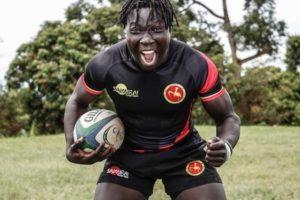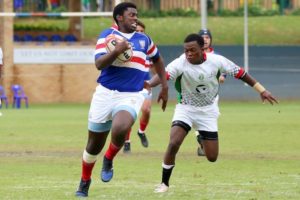When you watch a rugby match, all the players look enormous. If you’re on the leaner side, this might discourage you from taking up a game of rugby.

Prospective players frequently ask if there is a particular body type or minimum height requirement to play the sport. Here’s all you need to know
Who Can Play Rugby?
Rugby is a physically demanding contact sport. It requires a unique combination of strength, speed, agility, and endurance.
Rugby players must have a high level of physical fitness and skill to perform at their best on the field.
They need to be able to run, jump, tackle, and pass the ball with precision and accuracy.
Rugby players generally have high levels of muscle mass and low body fats.
This explains the common misconception that only people on the larger side can play rugby.
However, this is not the only requirement for rugby players.
Does Body Type Matter as a Rugby Player
There is no one “ideal” body type for a rugby player. Successful players come in a range of shapes and sizes.
This is because different positions on the field require different physical attributes.
For example, forwards tend to be larger and more powerful, with a focus on strength and physicality.
They need to be able to win the ball in the scrum and maul and make effective tackles.
Backs, on the other hand, tend to be smaller and more agile, focusing on speed and quick movements.
They need to be able to run and pass the ball quickly and make effective tackles in open play.
While body type can play a role in rugby, it is not the most important factor in determining success.
Some successful rugby players are tall and lean, while others are short and stocky.
Ultimately, what matters most is a player’s level of skill, fitness, and mental toughness.
Their ability to work effectively with their teammates also matters.
A player must be dedicated, hard-working, and committed to improving their skills and fitness on and off the field.
Different Positions in Rugby and the Required Body Type
There are fifteen positions in total on a rugby field. The first eight places are known as the forwards, and the other seven positions are known as the backs.
The forwards play a very physically demanding position and participate in the scrum and lineout. Despite being swift and agile, the backs still have a physical dexterity about them.
Here is a brief outline of the positions and the ideal body type.
Prop

Props are typically the larger, stronger players on the team and are situated at the front of the scrum.
They need to be powerful, with a low centre of gravity and have good upper body strength to win the scrum battles.
Hence, they are usually tall and heavy, with a solid build. On average, they weigh 118 kg.
Hooker
Hookers are also located in the front row of the scrum, between the two props.
They must also have the ability to throw accurately in the lineout. They are usually shorter and stockier than the props, with a thick build.
They typically weigh between 106kg – 118kg.
Lock
Locks are the tallest players on the team. They stay in the second row of the scrum.
Typically, they must be strong with good jumping ability to win the ball in the lineout. They are usually tall and heavy, with a muscular build.
Flanker
Flankers are located on either side of the scrum and are the most mobile forwards on the team.
They need to be fast, agile and have good ball-handling skills to make tackles and defend.
They are usually shorter and lighter than the props and locks, with a lean, muscular build.
Number 8
The number 8 is located at the back of the scrum and is responsible for picking up the ball from the base of the scrum.
They have to run into opponents. Evidently, they need to be strong, with good ball control and tackling skills.
Scrum-half
The scrum-half is responsible for delivering the ball from the back of the scrum and setting up attacks.
They need to be quick, agile and have good ball-handling and passing skills. They are usually the smallest in the team meaning they are shorter and lighter than the forwards.

Fly-half
The fly-half is responsible for directing the team’s attack and kicking the ball. They are usually shorter and lighter than the forwards.
Fly halves tend to weigh between 77 kg and 90 kg, although there are exceptions on both ends of the spectrum.
Centres
Centres are the main attacking players in the backline. They are responsible for running with the ball and making tackles. They typically weigh 95-99 kg.
Wingers
Wingers are the fastest players on the team. They are responsible for finishing off attacking moves by scoring tries.
They need to be very tricky, nimble and have good ball-handling skills. Larger wingers weigh 150 kg, while smaller ones weigh about 90 kg.
Height and weight aren’t necessarily a factor that determines whether you’ll make a good winger.
Fullback
The fullback is responsible for catching and returning kicks and providing a last line of defense. They need to be quick, agile and have good catching and kicking skills.
They are also usually shorter and lighter than the forwards, within the range of 90kg.
How Big Do You Have to Be to Play Rugby?
On average, forwards weigh between 112.55kg. Backs weigh 91.8kg on average. Overall, this amounts to 102.21kg.
However, these are merely general guidelines. There can be variations in body type and attributes depending on the individual player and the team’s strategy.
It’ll be difficult to find any authentic minimum or maximum weight limits out there. The heaviest players in the game are mostly born that way.
No amount of training can compensate for that.
Qualities You Need to Become a Rugby Player
Instead of being preoccupied with your body type, focus on other attributes that could make you a good rugby player.
Physical Fitness
Rugby is a physically demanding sport that requires a high level of physical fitness.
Players need to have good cardiovascular endurance, strength, speed, agility, and flexibility to perform well on the field.
Skill and Technique
Rugby players need to have a good understanding of the rules and techniques of the game. Skills such as tackling, passing, kicking, and running with the ball are essential.
Mental Toughness
Rugby is a tough sport that requires mental toughness and resilience.
Players need to be able to cope with the physical demands of the game and maintain their focus and concentration throughout the match.
NOTE
You can join a local rugby club or team to get started and learn from experienced players and coaches.
They can also designate you a befitting role after watching you in action. Otherwise, you might have to bulk up for a few months.
With dedication, hard work, and perseverance, nothing stops you from becoming a successful rugby player.
Conclusion
Rugby players are skilled athletes who excel at a physically demanding and challenging sport.
However, Rugby is a game for people of various shapes and sizes. Also, technique is more crucial than size or weight.
A lighter, leaner person may move faster on the field and make greater use of space than a larger person.

I was working as a mountain guide, probably all around the planet. One day, I met my wife in the mountains, literally on top of the world. Now, I have a beautiful family and three kids, so I don’t have much time for climbing, but sometimes I go camping with my friends. I am also into gym workouts, and I can’t imagine my life without sports.
Since I ended my professional career as a climbing guide, I’ve been giving personal classes and helping amateurs to get ready for conquering their first peaks. Also, that’s how the whole blog idea appeared.





